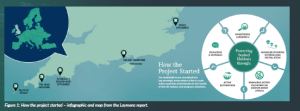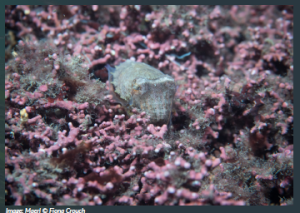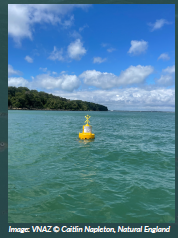Together, our marine conservation partnership aimed to: promote awareness of these shallow, sensitive seabed habitats and their importance—including maerl beds as well as seagrass; reduce recreational pressures on these sensitive habitats through education, outreach and targeted training; restore and protect sensitive habitats; and provide evidence of what works and share lessons learned.
The LIFE Recreation ReMEDIES (Reducing and Mitigating Erosion and Disturbance Impacts affEcting the Seabed) project was a £2.5 million, five-year initiative to protect and restore fragile marine habitats—seagrass and maerl—within five Special Areas of Conservation (SACs) in southern England. Co-funded by the EU LIFE programme and led by Natural England, it was launched in July 2019. The project was delivered in partnership with Plymouth City Council, the Marine Conservation Society, the Ocean Conservation Trust, the Tamar Estuaries Consultative Forum, and The Green Blue (Royal Yachting Association).
Seagrasses stabilise the seabed, clean surrounding seawater and absorb and capture carbon, helping to reduce the impact of climate change. Mearl is a rare, hard, pink alga that forms a complex structure, providing protection for invertebrates and small fish. Maerl is fragile and incredibly slow growing, making it vulnerable to damage.
Advanced mooring systems (AMS)
A major challenge was to reduce the damage caused by boat anchors. ReMEDIES implemented solutions, including AMS, which allow boats to moor securely without damaging seagrass. AMS use buoy or bungee systems to keep heavy chains off the seabed. Seventeen AMS were installed, protecting up to 2000 square metres of seagrass from anchor and chain/line scouring. Feedback from mooring owners and harbour authorities was positive, and the project established a UK-wide AMS network to share best practices. See AMS Good Practice Guide for information.
Active restoration
Active restoration was a cornerstone of the project. Using innovative technology, over seven hundred volunteers from institutions like the University of Plymouth and National Oceanography Centre packed 60 000 biodegradable seed bags for planting in Plymouth and the Solent. Divers collected seagrass seeds, which were then cleaned and grown in a lab into seagrass ‘pillows’. These were then replanted to expand and restore meadows. A seed injection gun was also used to plant seeds directly into the seabed. Eight hectares of seagrass were planted (equivalent to 11 football pitches).
For more information, see the Best Practice Guide and Best Practice Report.
Voluntary no anchor zones (VNAZ)
Engaging with boaters was vital to ReMEDIES’ success. The project set up three VNAZ to protect sensitive seagrass areas. In Osborne Bay, located on the Isle of Wight’s northeast coast, boaters were consulted and eight marker buoys were installed to define the first VNAZ in the Solent Maritime SAC. Ongoing monitoring will assess its effectiveness. ReMEDIES also launched The Green Guide to Anchoring and Moorings, filled with practical advice for boaters with over 5500 downloaded or distributed so far.
Education and outreach
Education and outreach formed a key component of ReMEDIES. Over 29 000 people, through local communities, schools and water user groups, were engaged in learning about marine habitats and the importance of seabed protection. The project organised outreach events, surveys and discussions to raise awareness and gather data on boating activities.
The Ocean Conservation Trust, supported by the Marine Conservation Society and the Royal Yachting Association, developed a comprehensive education programme, reaching over 4800 individuals. These efforts fostered a deeper connection to marine environments and cultivated a community of ocean conservation advocates.
National and international coverage
ReMEDIES aimed to raise awareness of seabed habitats, both nationally and internationally. Media coverage played a significant role, with over 35 print and online articles featuring in publications such as The Daily Telegraph, ScubaDiver Magazine and Environment Journal. TV appearances included BBC Countryfile and ITV West Country; radio interviews included BBC Radio Cornwall and BBC Radio Sheffield. The project also gained attention at international events, such as the World Seagrass Symposium in Napoli, the UK Seagrass Symposium and the European Scientific Diving Community with UN representatives.
The project’s achievements were showcased on the Save Our Seabed website and through engaging films, including Underwater Heroes and an end of project film. Additionally, a project summary report captures the highlights and outcomes of the project.
Monitoring and research
A range of monitoring techniques were used, including echosounders, drop-down video surveys and diver surveys. Echosounders mapped seagrass meadows, while video surveys captured detailed images for analysis. The Natural England Scientific Dive Team conducted detailed surveys, visually inspecting seagrass and assessing coverage. They also collected samples for analysis to evaluate the health of the meadows. Data from these surveys were compared to 2018 data, providing insights into habitat health over time. Volunteers from Seasearch, a national network of divers, also collected data on seagrass species and associated fauna, further enriching the project’s findings.
A comprehensive behavioural science evaluation gathered data from over 250 recreational boaters on their anchoring and mooring practices, providing insights into the impacts of these activities on seagrass meadows. Although there were limitations with the data, the evaluation conducted by Powellite Impact Ltd found that the percentage of boaters who reported ‘never anchoring in seagrass’ was higher in 2024 (41 per cent) than in 2021 (17 per cent). The use of advanced mooring systems (AMS) grew from 5 per cent in 2021 to 22 per cent in 2024. Although based on limited data, preliminary results suggest a positive change in behaviour after the installation of a voluntary no anchor zone (VNAZ) in Osborne Bay: only 21 per cent of boaters anchored in seagrass in 2024 compared to 43 per cent of boaters in summer 2023.
Long-term benefits
The project enhanced understanding of seagrass condition and the local community’s needs. Insights gathered will guide future efforts to protect seagrass and maerl. Marine licences for AMS installation and seagrass planting were secured through the Marine Management Organisation, offering lessons for future marine restoration projects.
New scientific techniques were trialled in the planting of harvested seeds, helping to restore and expand seagrass meadows. Continued monitoring provided valuable data for ongoing management and condition assessment. The national and international interest in seagrass restoration means that ReMEDIES’ lessons will have a lasting impact.
Following two successful AMS workshops in Plymouth and Southampton, ReMEDIES created a network of over 40 UK representatives from NGOs, public authorities and sailing clubs, helping to share knowledge and develop further trials in areas like Portland and Strangford Lough.
The future
ReMEDIES made significant strides in preserving and restoring marine habitats, and its work continues to influence future restoration efforts*. Protocols for implementing VNAZs and AMS will be refined, while community outreach efforts will ensure greater awareness of the need to protect these vital ecosystems. Formal education programmes may play a key role in building global support for marine conservation, ensuring that these vital ecosystems are protected for future generations.
The project’s results were presented at the End of Project Conference and shared through reports on the website and the Access to Evidence portal. The lessons learned will continue to shape future seagrass conservation efforts, ensuring that these vital marine habitats thrive long into the future.
*Useful Evidence for Seagrass Restoration
Co-funded by the European Union. Views and opinions expressed are, however, those of the author(s) only and do not necessarily reflect those of the European Union or CINEA. Neither the European Union nor the granting authority can be held responsible for them.
PROJECT SUMMARY
Together, our marine conservation partnership aimed to: promote awareness of these shallow, sensitive seabed habitats and their importance—including maerl beds as well as seagrass; reduce recreational pressures on these sensitive habitats through education, outreach and targeted training; restore and protect sensitive habitats; and provide evidence of what works and share lessons learned.
PROJECT PARTNERS
Plymouth City Council, The Marine Conservation Society, The Ocean Conservation Trust, The Tamar Estuaries Consultative Forum and the Royal Yachting Association worked in partnership with Natural England as lead beneficiary. We also worked closely with stakeholders, including The Wildlife Trusts (Essex, Hampshire and Isle of Wight and Cornwall), Community and Conservation Groups, diving and sailing clubs and sponsors, including Valeport, Naturesave and Zurich.
PROJECT LEAD PROFILE
Fiona Tibbitt has been passionate about marine conservation since she was a teenager and learned to dive over 35 years ago. She studied Oceanography and Marine Biology at Southampton University and did an MSc at Heriot-Watt University in Marine Resource Development and Protection alongside an HSE Professional Scuba course in Orkney. Fiona has worked at Natural England for 12 years.
PROJECT CONTACTS
Fiona Tibbitt
Natural England, 2nd Floor Dragonfly House, 2 Gilders Way, Norwich, NR3 1UB.
Email: LifeRemedies@naturalengland.org.uk
Web: SaveOurSeabed.co.uk
More information
Visit SaveOurSeabed.co.uk.
Figure legends
Figure 1: How the project started – infographic and map from the Laymans report.
Figure 2: AMS based on a graphic by the RYA.
Image: Maerl © Fiona Crouch
Image: VNAZ © Caitlin Napleton, Natural England






